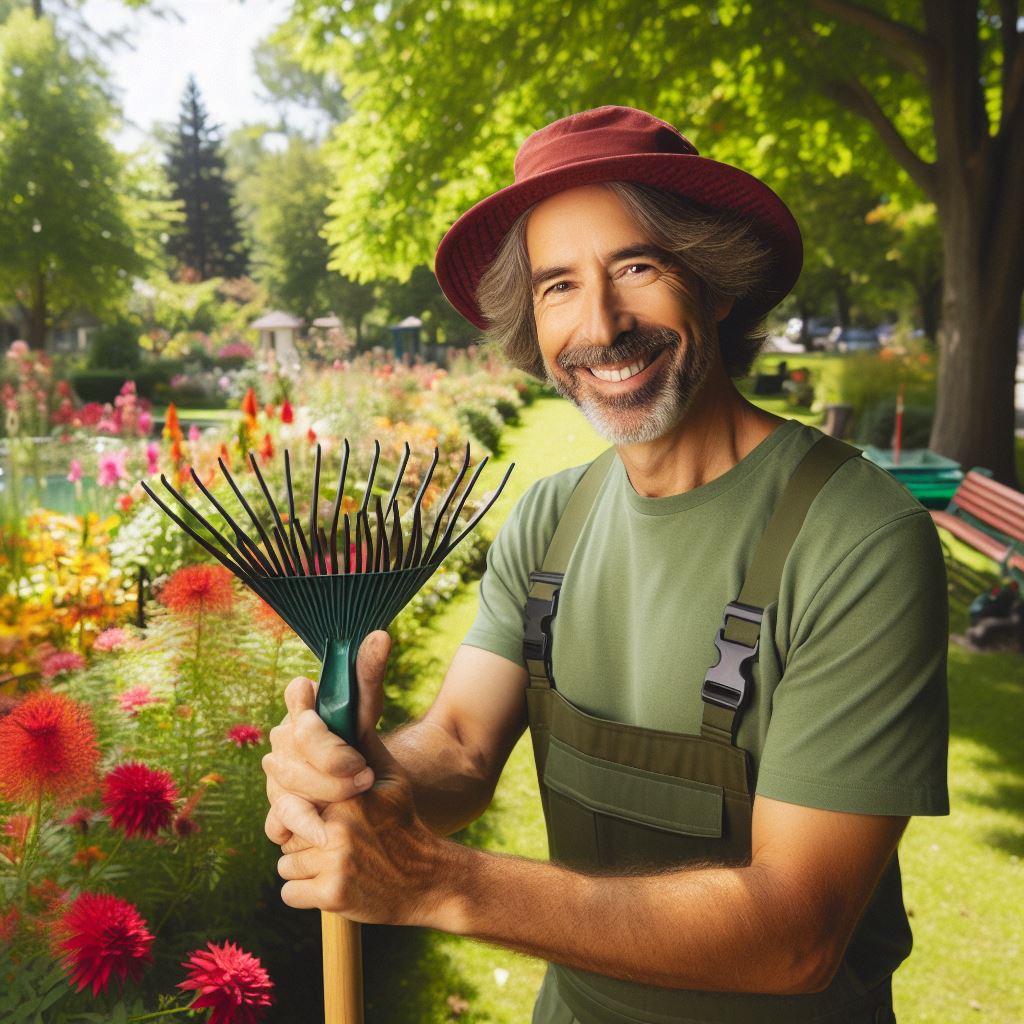Introduction
Importance of landscaping for beginners
Landscaping plays a crucial role in transforming a property, especially for beginners who may lack the knowledge and experience in creating a beautiful outdoor space.
It not only enhances the aesthetic appeal but also increases the value of the property.
From enhancing curb appeal to creating a cozy outdoor retreat, landscaping allows homeowners to personalize their space and make it more inviting.
Purpose of the guide
In this guide, we will cover various aspects of landscaping for beginners in Canada.
Whether you have a small backyard or a sprawling garden, we will provide tips and techniques to help you make the most of your space.
We will discuss the importance of planning, selecting the right plants, and creating focal points to achieve a well-balanced and visually pleasing landscape.
Additionally, our guide aims to educate beginners about the different Canadian regions and their specific climatic conditions.
This knowledge will enable homeowners to choose plants that are suitable for their particular region, ensuring better growth and longevity.
By following the advice in this guide, beginners can avoid common mistakes and save time, effort, and money.
Whether you are starting from scratch or looking to revamp your existing landscape, this guide will equip you with the knowledge and confidence to create a stunning outdoor space that you can enjoy for years to come.
Choosing the Right Plants
Choosing the right plants for your landscaping project is crucial for creating a beautiful and thriving outdoor space.
In this section, we’ll discuss how to select plants that are suitable for Canadian climates and the factors to consider when deciding between native and non-native species.
Climate and Zone Considerations
Canadian climate variations
Canada is known for its diverse weather conditions, ranging from the cold winters of the north to the mild coastal climates of the west.
It’s important to understand the specific climate of your region, as it will greatly impact the types of plants that can survive and thrive in your garden.
Identifying the appropriate hardiness zones
The country’s vast geography is divided into different hardiness zones, which indicate the average minimum temperature a plant can withstand.
By knowing your zone, you can select plants that are more likely to survive in your specific area.
This information is readily available through online resources or by consulting with local gardening experts.
Native Plants vs. Non-Native Plants
Benefits of native plants
Native plants are species that naturally occur in a specific region without human introduction.
They have adapted over time to the local conditions, making them well-suited for their environment.
Using native plants in your landscaping offers several benefits, such as:
Adaptability: Native species are already acclimated to the local climate, soil types, and pests, reducing the need for excessive maintenance and interventions.
Wildlife support: Native plants provide food, habitat, and shelter to local wildlife, contributing to biodiversity and ecological balance.
Sustainability: Since native plants are adapted to local conditions, they typically require less water, fertilizer, and pesticides, making them more environmentally friendly.
Exploring non-native plants suitable in Canadian landscapes
While native plants are highly recommended in landscaping, there are also non-native options that can thrive in Canadian climates.
These plants may have unique characteristics, such as vibrant flowers or interesting foliage, that can add diversity to your garden.
When considering non-native plants, it’s important to ensure they are well-suited to your region’s climate and won’t become invasive or harm the local ecosystem.
In essence, selecting the right plants for your Canadian landscape involves considering the climate variations across the country, identifying the appropriate hardiness zones, and deciding between native and non-native species.
Unlock Your Career Potential
Visualize a clear path to success with our tailored Career Consulting service. Personalized insights in just 1-3 days.
Get StartedBy understanding these factors, you can create a beautiful and sustainable garden that thrives in your specific environment.
Read: Pros & Cons of a Career in Landscaping
Basic Landscape Design Principles
When designing your landscape, there are fundamental principles you need to consider to create a visually appealing and harmonious outdoor space.
This section will discuss the basic landscape design principles of balance and symmetry, scale and proportion, as well as focal point and visual interest.
Balance and Symmetry
Balance is an important aspect of landscape design, as it creates a sense of equilibrium and visual harmony.
It involves the equal distribution of visual weight in a design, ensuring that no individual element overpowers the others.
To achieve balance, consider the size, shape, color, and texture of the different elements in your landscaping.
For example, if you have a large tree on one side of your yard, balance it out by adding a group of smaller shrubs or plants on the other side.
Symmetry, on the other hand, involves creating a mirror-like arrangement or using matching elements to achieve a sense of harmony.
It can be achieved by placing identical elements, such as plants or structures, on both sides of a central axis.
This can bring a sense of order and formality to your garden.
However, it’s important to note that symmetry doesn’t always mean perfectly identical elements.
You can achieve symmetry by using elements that have similar visual weight or characteristics, creating a pleasing and balanced overall design.
Scale and Proportion
Scale and proportion play a significant role in landscape design.
Scale refers to the size of various elements in relation to each other and the surrounding environment.
It’s important to consider the size of your yard and select elements that are proportional to the space.
For example, if you have a small yard, large structures or plants can overwhelm the space, while tiny elements may get lost in a large yard.
Aim for a harmonious balance between all the elements to create an aesthetically pleasing design.
Proportion, on the other hand, refers to the size and placement of different elements to create a visually balanced composition.
It involves considering the relationship between objects and their surroundings.
A well-proportioned landscape design takes into account how different elements, such as trees, shrubs, flowers, and hardscape features, work together to create a cohesive and pleasing visual effect.
Pay attention to the height, width, and overall size of each element when planning your landscape to achieve harmonious proportions.
Focal Point and Visual Interest
A focal point is a central element in landscape design that draws attention and creates a visual anchor.
It can be a striking plant, a unique sculpture, a water feature, or any other element that stands out from the rest of the design.
Focal points help guide the viewer’s eye and add interest to the overall landscape.
When selecting a focal point, consider its placement and how it relates to the surrounding elements.
A well-placed focal point can transform a simple garden into a captivating outdoor space.
In addition to a focal point, creating visual interest in your landscape involves incorporating various elements that catch the eye.
This can include a mix of textures, colors, and shapes.
Consider using a variety of plants with different foliage, flowers, and heights to add depth and dimension to your yard.
Incorporating pathways, rocks, or other hardscape features can also contribute to the visual interest of your landscape design.
Experiment with different combinations and arrangements to create a unique and visually appealing outdoor space.
By understanding and applying the basic landscape design principles of balance and symmetry, scale and proportion, as well as focal point and visual interest, you can create a well-designed and aesthetically pleasing outdoor space.
These principles serve as guidelines to help you make informed decisions when planning and implementing your landscaping ideas.
Remember to consider the specific conditions of your yard and personalize your design to suit your preferences and needs.
With careful consideration and creativity, you can transform your outdoor space into a beautiful and inviting landscape.
Read: Canadian Wildlife-Friendly Landscaping Ideas
Essential Landscaping Tools and Materials
Basic Garden Tools
- Spade: A must-have tool for digging, edging, and transplanting.
- Rake: Essential for leveling soil, spreading mulch, and removing debris.
- Garden Fork: Perfect for loosening soil and mixing in compost or fertilizer.
- Hand Trowel: Ideal for planting small plants, removing weeds, and cultivating soil.
- Pruning Shears: Necessary for trimming shrubs, trees, and tidying up plants.
- Garden Hose: A reliable water source to keep your plants hydrated.
- Wheelbarrow: Great for transporting heavy materials like soil, rocks, or mulch.
- Gardening Gloves: Protect your hands from dirt, thorns, and other potential injuries.
- Shovel: Essential for moving larger amounts of soil, gravel, or mulch.
- Lawn Mower: Maintain your lawn’s health and appearance by cutting the grass regularly.
Tips for tool selection
Choosing the right tools for landscaping in Canada is crucial, as the weather conditions can be harsh.
Here are some tips:
- Look for tools made of durable materials such as stainless steel or carbon-fiber.
- Opt for tools with ergonomic handles to reduce strain on your hands and arms.
- Consider tools with a warranty or guarantee, ensuring their longevity.
- Invest in tools that are suitable for both dry and wet conditions.
- Research and read reviews to find reliable Canadian brands known for quality.
Soil and Mulch
The type of soil used in landscaping can significantly impact the growth and health of plants.
Understanding the different types is essential:
- Clay Soil: Retains water well but should be amended with organic matter to improve drainage.
- Sandy Soil: Drains quickly and requires frequent watering and fertilization.
- Loam Soil: Ideal for gardening, as it combines the benefits of clay, silt, and sand.
- Peat Soil: Acidic and rich in organic matter, perfect for acid-loving plants like azaleas.
- Chalky Soil: Alkaline and drains poorly, often requiring amendments to support plant growth.
Mulching is a beneficial practice that helps retain moisture, suppress weeds, and improve soil health.
Here are various mulching options:
- Wood Chips: Slowly decompose, adding organic matter to the soil and enhancing its structure.
- Straw or Hay: Lightweight and inexpensive, ideal for vegetable gardens or temporary use.
- Rubber Mulch: Long-lasting and low maintenance, but may not improve soil quality.
- Grass Clippings: Free and nutrient-rich, but should be applied thinly to avoid matting.
- Leaves: Best when shredded, they enrich the soil as they break down gradually.
Choose the appropriate mulching option based on your specific needs and preferences.
Read: Budget Landscaping: Save Money in Your Yard

Step-by-Step Landscaping Process
Site Preparation
Site preparation is a vital step in the landscaping process.
Start by clearing existing vegetation, including unwanted plants, trees, or shrubs.
This ensures a clean slate to work with.
Additionally, conduct soil testing to understand its composition and make any necessary amendments.
By analyzing the soil, you can determine if it lacks essential nutrients or requires adjustments to its pH levels.
Design and Planning
Once you’ve prepared the site, it’s time to move on to design and planning.
Create a rough sketch or blueprint that visually represents your landscaping ideas.
This will help you envision the final result and guide you during the implementation phase.
Consider the elements and principles of design, such as balance, harmony, color, and scale.
These factors play a significant role in creating an aesthetically pleasing landscape.
Plant Selection and Installation
Next, focus on plant selection and installation.
Choose plants that are suitable for your specific climate, considering factors such as sunlight exposure, soil type, and maintenance requirements.
Research the plants’ growth habits, potential height, and spread to ensure they fit well within your design.
When planting, follow proper techniques, such as digging appropriate-sized holes and backfilling with soil.
Be mindful of spacing guidelines to prevent overcrowding as the plants mature.
Maintenance and Care
Maintenance and care are ongoing responsibilities when it comes to landscaping.
Develop a watering, fertilizing, and pruning routine to ensure the health and vitality of your plants.
Different plants have varying water requirements, so it’s essential to be diligent with watering.
Provide adequate nutrients through fertilizers to promote healthy growth.
Regular pruning helps maintain the shape and remove any diseased or damaged parts.
Additionally, develop strategies for year-round landscape maintenance, including seasonal tasks like mulching, weeding, and cleaning up fallen leaves.
Remember, landscaping is an evolving process.
As your plants grow, your landscape may require adjustments and periodic maintenance.
Stay observant and adaptable, making necessary changes to ensure your outdoor space thrives.
By following these step-by-step guidelines, you can navigate the landscaping process with confidence, resulting in a beautiful and sustainable Canadian landscape.
Read: Landscaping Trends 2024: What’s Hot in Canada
Common Landscaping Challenges and Solutions
Weather and climate play a significant role in successful landscaping.
Canada, being a country known for its diverse weather conditions, poses unique challenges for beginners in this field.
However, with proper knowledge and implementation of effective techniques, these challenges can be overcome.
This section explores common landscaping challenges faced by beginners in Canada and provides practical solutions.
Dealing with Canadian Weather Extremes
- When winter strikes, it is essential to protect your plants from freezing temperatures and heavy snow. Insulate delicate plants by covering them with burlap or using a protective layer of mulch.
- During scorching summers, ensure your plants have access to sufficient water. Install a drip irrigation system or use a soaker hose to provide deep watering, preventing plants from drying out.
- Implementing drought-resistant gardening techniques can help combat water scarcity. Choose plants that are tolerant to dry conditions, such as lavender, sedum, or yarrow. Additionally, adding a layer of organic mulch can help retain moisture in the soil.
Pest and Weed Management
- Identify common pests and weeds that frequently plague Canadian landscapes, such as aphids, slugs, dandelions, and crabgrass. Research their characteristics and behavior to develop effective control strategies.
- Instead of relying on harmful pesticides, opt for eco-friendly alternatives to control pests and weeds. For example, introduce natural predators that feed on pests, such as ladybugs for aphids or nematodes for grubs. Manual removal or solarization can be effective against weeds.
- Maintain a healthy garden through proper soil preparation, adequate nutrition, and regular pruning. Healthy plants are more resistant to pests and weeds, ensuring their long-term survival.
Overcoming common landscaping challenges in Canada requires adaptability and resourcefulness.
By understanding the specific needs of your plants and implementing effective techniques, you can create a thriving landscape that withstands weather extremes and remains resilient against pests and weeds.
Remember, continuously educating yourself about best practices and staying updated on new techniques can further enhance your landscaping skills.
Before you know it, you’ll be able to tackle any challenge that comes your way, and your Canadian landscape will flourish with beauty and vitality.
Conclusion
Landscaping is a fun and rewarding activity that can transform your outdoor space.
In this guide, we have discussed some key points to keep in mind when starting out as a beginner landscaper.
We have emphasized the importance of having a plan, making a wish list, and using containers to accent difficult areas.
We have also highlighted the significance of working with the natural environment around you, and not against it.
Essentially, we encourage readers to embrace landscaping as beginners.
Don’t be afraid to experiment and try new things.
Remember, this is supposed to be fun! You are creating a space for you to enjoy.
If you need further guidance, there are many resources available to help you along the way.
The Old Farmer’s Almanac Home Gardening Landscaping Design is a great resource for tips and advice on planning and designing your outdoor space.
You can also check out Engineer Warehouse’s list of landscape tools and tips for more inspiration.




